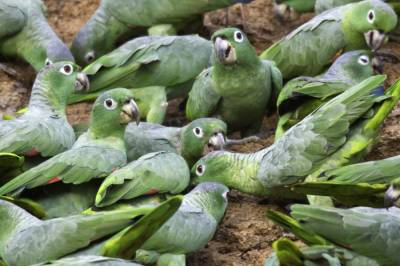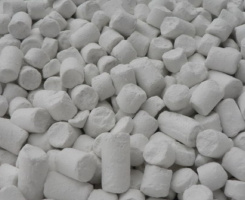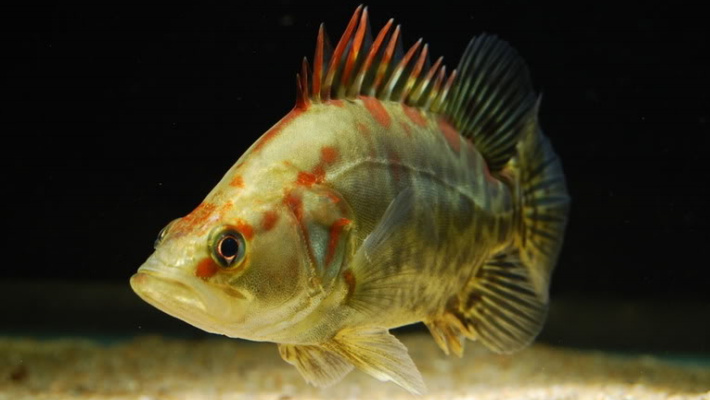|
Phenomenon of soil ingestion, or geophagy, attracts
an attention of numerous researchers for years (Woywodt & Kiss, 2002). Geophagy is not exhibited everywhere, but it is widespread in many
animals and human (for review, see Mahaney & Krishnamani, 2003; Limpitlaw,
2010).
Johns & Duquette (1991) suggest that the physiological
significance of geophagy made it important in the evolution of human dietary
behaviour.
More than 50
species of animals have been reported to ingest various types of clays, salt
and other Earth materials, in particular at sites named "licks”. In general, this
form of dietary behaviour allows an animal to provide its organism with the
needed nutrients, solve gastrointestinal and intoxication problems, suppress some maladies and improve general vital
indexes (Limpitlaw, 2010).
In
particular, parrots are ones of the most studied soil-eaters (e.g., Gilardi et
al., 1999; Brightsmith, 2004; Brightsmith et al., 2004, 2008). 
Members of
our group have started the first experiments with clay-eating in fishing in the
end of 1980s, after lucky detectiing an open deposit of high quality white clay on an abrupt bank of
the Dnipro river (localities in Ukraine).
First of all, this clay was used to prepare fishing groundbaits (with an
excellent attractive effect). In the subsequent years, four basic ways to
use clay-eating in fishing (see below) were elaborated. Taking into account the current hazardous ecological situation in the most part of water bodies, we
have decided to enter such technological products as the Dietary Clay Pellets & Dietary Clay Boilies into mass production.
In total, the
following basic clayey products (of the white, green, yellow, orange and red
colors) are elaborated:
1. Paste,
or Plasticine
2. Polenta
3. Dietary
Clay & Rice Pellets
4. Dietary
Clay & Rice Boilies 
In the latter
two cases, the white processed rice (up to about 30 weight percent) has been
used in the capacity of an extender and binder. This rice is lighter than the
common rice meal and flakes. It quickly dissolves in the water. Yet, it is
quickly digested in the intestines of fish. Recall also, rice products (without
salt, sugar and spices) are widely and effectively used in the human diets.
To test
dietary pellets and boilies, one week pre-baiting campaigns with the everyday
morning and evening sessions were conducted in the field. For the first
presentation in the 1st day, items enhanced with powder, liquid or spray
attractants (one type within all sessions) were only used. In the 2nd, 3rd and
4th days, mixes of enhanced and non-enhanced items, taken in the percent ratio
of 70:30, 50:50 and 30:70, were used. Finally, in the remaining days,
non-enhanced pellets and boilies or even practically blank kaolin balls with
small amount of binder were only offered.
According
to our observations, to the end of the pre-baiting campaigns fish usually
readily eat non-enhanced or blank clayey pellets (used for roach, Rutilus rutilus, and other relatively
small fish) and boilies (used for carp, Cyprinus
carpio), demonstrating in this way that they include these items in their
natural, in water bodies with weak angling pressure, or semi-narural, in other
cases, diets.
Generally,
this form of dietary behaviour, named dietary
self-selection or macronutrient
self-selection, is determined by an individual experience of an animal and
reflects the positive associations between some macronutrients and physiological
state of this animal, which are established during its learning in the nature, aquaculture,
zoo or laboratory (for review, see Moore et al., 2005; Huntingford et al., 2012).
These macronutrients provide energy requirements, optimum protein, fat and carbohydrate levels, or, more
specifically, vitamin, mineral and other requirements.
In respect of fish, the
phenomenon of dietary self-selection has attracted an undivided attention of numerous researchers approximately from the second part of 1990s (e.g., Sánchez-Vázquez
et al., 1999; Aranda et
al., 2000, 2001; Yamamoto et al., 2001; Rubio et al., 2003; Vivas et al., 2003;
Yamamoto et al., 2003). Of course, direct
biochemical, trophological and biomedical investigations of clayey diets in
fish will be useful to the further development of diet designing in aquaculture,
fishing (baits, lures, groundbaits) and related areas.
Basic References
Aranda A.,
Sánchez-Vázquez F.J., Zamora S., Madrid J.A. 2000. Self-design of fish diets by means
of self-feeders: validation of procedures. Journal
of Physiology and Biochemistry 56, 155-166.
Aranda A.,
Sánchez-Vázquez F.J., Madrid
J.A. 2001. Effect of short-term fasting on macronutrient self-selection in sea
bass. Physiology & Behavior 73,
105-109
Brightsmith
D. J. 2004. Effects of weather on parrot geophagy in Tambopata, Peru. Wilson Bulletin 116, 134-145
Brightsmith
D. J., Aramburú R. 2004. Avian geophagy and soil characteristics in Southeastern Peru. Biotropica
36, 534-543
Brightsmith
D. J., Taylor J., Phillips T.D. 2008. The roles of soil characteristics and toxin adsorption in avian geophagy. Biotropica 40, 766-774
Gilardi
J.D., Duffey S.S., Munn C.A.,
Tell L.A. 1999.
Biochemical functions of geophagy in parrots: Detoxification of dietary toxins
and cytoprotective effects. Journal of Chemical Ecology 25, 897-922
Huntingford
F., Jobling M., Kadri S. (Editors). 2012. Aquaculture and Behavior. Wiley-Blackwell,
The Atrium, Southern Gate, Chichester,
United Kingdom
Johns T.,
Duquette M. 1991. Detoxification and mineral supplementation as functions of
geophagy. American Journal of Clinical Nutrition 53, 448-456
Limpitlaw
U.G. 2010. Ingestion of Earth materials for health by humans and animals. International
Geology Review 52, 726-744
Mahaney
W.C., Krishnamani R. 2003. Understanding geophagy in animals: standard
procedures for sampling soils. Journal of Chemical Ecology 29, 1503-1523
Moore
B., Marsh K., Wallis I. 2005. Taught by
animals: how understanding diet selection leads to better zoo diets. International
Zoo Yearbook 39, 43-61
Rubio V.C.,
Sánchez-Vázquez F.J., Madrid
J.A. 2003. Macronutrient
selection through postingestive signals in sea bass fed on gelatine capsules. Physiology & Behavior 78, 795-803
Sánchez-Vázquez
F.J., Yamamoto T., Akiyama T., Madrid
J.A., Tabata M., 1999. Macronutrient
self-selection through demand-feeders in rainbow trout. Physiology & Behavior 66, 45-51
Vivas M.,
Sánchez-Vázquez F.J., Garcia Garcia B., Madrid J.A. 2003. Macronutrient self-selection in
European sea bass in response to dietary protein or fat restriction. Aquaculture Research 34, 271-280
Yamamoto
T., Shima T., Furuita H., Shiraishi M., Sánchez-Vázquez F.J., Tabata M. 2001. Influence of decreasing water
temperature and shortening of the light phase on macronutrient self-selection
by rainbow trout Oncorhynchus mykiss
and common carp Cyprinus carpio. Fisheries Science 67, 420-429
Yamamoto T.,
Shima T., Furuita H., Suzuki N. 2003. Effect of water temperature and
short-term fasting on macronutrient self-selection by common carp (Cyprinus carpio). Aquaculture 220, 655-666
Woywodt A.,
Kiss A. 2002. Geophagia: the history of earth-eating. Journal of the Royal Society of Medicine
95, 143-146
|








 SUBSCRIBE
SUBSCRIBE




